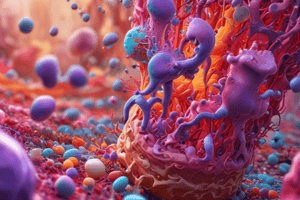Podcast
Questions and Answers
What is the primary focus of pathology?
What is the primary focus of pathology?
- The study of causes and mechanisms of diseases
- The study of disease progression
- The study of structural and functional changes in disease (correct)
- The study of clinical features and their relation to changes
What is the difference between signs and symptoms?
What is the difference between signs and symptoms?
- Signs are the treatments for the disease, while symptoms are the preventative measures
- Signs are objective changes that the physician observes, while symptoms are subjective changes reported by the patient (correct)
- Signs are the patient's personal experience of the disease, while symptoms are measurable changes in body functions
- Signs are the causes of the disease, while symptoms are the effects of the disease
Which of the following is not one of the four divisions of pathology?
Which of the following is not one of the four divisions of pathology?
- Morphology
- Aetiology
- Pathogenesis
- Epidemiology (correct)
What does 'prognosis' refer to in the context of pathology?
What does 'prognosis' refer to in the context of pathology?
What does pathology study in relation to diseases?
What does pathology study in relation to diseases?
Which of the following is not a goal of pathology?
Which of the following is not a goal of pathology?
What type of cells sense tissue damage at the site of injury and release chemical mediators in acute inflammation?
What type of cells sense tissue damage at the site of injury and release chemical mediators in acute inflammation?
Which type of receptors play a key role in bridging the innate and adaptive immunity during inflammation?
Which type of receptors play a key role in bridging the innate and adaptive immunity during inflammation?
In acute inflammation, which phase involves changes in blood vessels to allow for increased blood flow and vascular permeability?
In acute inflammation, which phase involves changes in blood vessels to allow for increased blood flow and vascular permeability?
Which of the following is NOT an innate immune cell expressing Toll-like receptors?
Which of the following is NOT an innate immune cell expressing Toll-like receptors?
Which type of inflammation is characterized by the formation of abscesses and boils?
Which type of inflammation is characterized by the formation of abscesses and boils?
Which cells are part of the cellular phase of acute inflammation and play a role in phagocytosis?
Which cells are part of the cellular phase of acute inflammation and play a role in phagocytosis?
What is the primary function of inflammatory fluid exudates described in the text?
What is the primary function of inflammatory fluid exudates described in the text?
Which of the following is NOT a part of the local signs of acute inflammation?
Which of the following is NOT a part of the local signs of acute inflammation?
What stimulates the production of acute phase proteins like CRP and Fibrinogen?
What stimulates the production of acute phase proteins like CRP and Fibrinogen?
Which factor is responsible for fever during systemic response in acute inflammation?
Which factor is responsible for fever during systemic response in acute inflammation?
What is the fate of acute inflammation that leads to healing by connective tissue replacement?
What is the fate of acute inflammation that leads to healing by connective tissue replacement?
What is the role of fibrinogen in acute inflammation according to the text?
What is the role of fibrinogen in acute inflammation according to the text?
Which of the following is NOT a type of granuloma mentioned in the text?
Which of the following is NOT a type of granuloma mentioned in the text?
What is the characteristic microscopic feature of chronic specific inflammation?
What is the characteristic microscopic feature of chronic specific inflammation?
Which of the following is NOT a major cause of granulomatous inflammation according to the text?
Which of the following is NOT a major cause of granulomatous inflammation according to the text?
What type of inflammation is characterized by the focal accumulation of macrophages, lymphocytes, and fibroblasts?
What type of inflammation is characterized by the focal accumulation of macrophages, lymphocytes, and fibroblasts?
Which disease is NOT listed as a bacterial cause of granulomatous inflammation?
Which disease is NOT listed as a bacterial cause of granulomatous inflammation?
What type of inflammation usually starts as chronic according to the text?
What type of inflammation usually starts as chronic according to the text?
What is the main characteristic of suppurative inflammation?
What is the main characteristic of suppurative inflammation?
Which of the following microorganisms are commonly associated with suppurative inflammation?
Which of the following microorganisms are commonly associated with suppurative inflammation?
Which of the following is a characteristic feature of an abscess?
Which of the following is a characteristic feature of an abscess?
What is the primary mechanism by which pyogenic microorganisms contribute to suppurative inflammation?
What is the primary mechanism by which pyogenic microorganisms contribute to suppurative inflammation?
What is a boil?
What is a boil?
Which of the following best describes a carbuncle?
Which of the following best describes a carbuncle?




